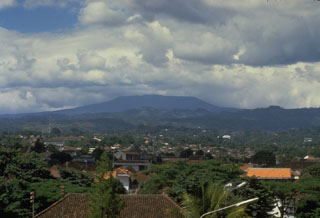Report on Tangkuban Parahu (Indonesia) — December 1985
Scientific Event Alert Network Bulletin, vol. 10, no. 12 (December 1985)
Managing Editor: Lindsay McClelland.
Tangkuban Parahu (Indonesia) Elevated fumarole temperatures in December
Please cite this report as:
Global Volcanism Program, 1985. Report on Tangkuban Parahu (Indonesia) (McClelland, L., ed.). Scientific Event Alert Network Bulletin, 10:12. Smithsonian Institution. https://doi.org/10.5479/si.GVP.SEAN198512-263090
Tangkuban Parahu
Indonesia
6.77°S, 107.6°E; summit elev. 2084 m
All times are local (unless otherwise noted)
Fumarole temperatures at Kawah Baru continued to climb through December, reaching a maximum of 171°C on 31 December. In January, temperatures have gradually declined to 148°C as of the 11th. No seismicity was recorded.
Geological Summary. Gunung Tangkuban Parahu is a broad stratovolcano overlooking Indonesia's former capital city of Bandung. The volcano was constructed within the 6 x 8 km Pleistocene Sunda caldera, which formed about 190,000 years ago. The volcano's low profile is the subject of legends referring to the mountain of the "upturned boat." The Sunda caldera rim forms a prominent ridge on the western side; elsewhere the rim is largely buried by deposits of the current volcano. The dominantly small phreatic eruptions recorded since the 19th century have originated from several nested craters within an elliptical 1 x 1.5 km summit depression.
Information Contacts: Suparto S. and T. Casadevall, VSI.

